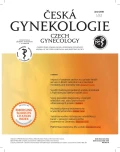Validation of a new tool for identification of barriers to cervical cancer prevention in Slovakia
Authors:
V. Szabóová 1; V. Švihrová 1; J. Švihra jr. 2; L. Rišková 3; H. Hudečková 1
Authors‘ workplace:
Ústav verejného zdravotníctva, Jesseniova lekárska fakulta, Martin, Univerzita Komenského, Bratislava, vedúca pracoviska prof. MUDr. H. Hudečková, PhD., MPH
1; Urologická klinika, Univerzitná nemocnica Martin, prednosta doc. MUDr. J. Ľupták, PhD.
2; Chirurgická klinika a transplantačné centrum, Univerzitná nemocnica a Jesseniova lekárska fakulta, Martin, Univerzita Komenského, Bratislava, prednosta prof. MUDr. Ľ. Laca, PhD.
3
Published in:
Ceska Gynekol 2018; 83(1): 30-35
Overview
Objective:
The aim of the work was to validate the Slovak version of the CPC-28 questionnaire (Beliefs about Papanicolaou and Cervical Cancer).
Design:
Original study.
Setting:
Department of Public Health, Jessenius Faculty of Medicine in Martin, Comenius University in Bratislava, in co-operation with gynaecological centers in University Hospital Martin and district Martin, Slovakia.
Methods:
The original English version of the CPC-28 questionnaire was translated into Slovak language. The questionnaire consists of 28 statements divided into six domains. Cronbach´s alpha coefficient was used to analyse the internal consistency of the questionnaire. Construction validity was evaluated by using Pearson‘s correlation coefficient. The results were processed in the statistical programs Epi Info™ 7.1.5. and Statistica 13, p-values < 0.05 were considered statistically significant.
Results:
The Slovak version of the questionnaire was provided to 27 women. The women were given two questionnaires, and one of them was filled in immediately (test). After 14 days they filled in and returned second questionnaire (retest). The value of Cronbach‘s alpha was > 0.8 in all six domains which demonstrates the high internal consistency of the questionnaire. Pearson‘s coefficient was > 0.7 in all six domains and p-values < 0.001.
Conclusion:
The validated CPC-28 questionnaire in the Slovak language can be administered to women to collect data for identification of barriers to cervical cancer screening among women.
Keywords:
barriers, validation, questionnaire CPC-28, cervical cancer, screening
Sources
1. Anttila, A., von Karsa, L., Aasmaa, A., et al. Cervical cancer screening policies and coverage in Europe. Eur J Cancer, 2009, 45(15), p. 2549–2558.
2. Dušková, J., Beková, A., Dvořák, V., et al. Výsledky narodního programu screeningu karcinomu deložního hrdla v České republice. Klin Onkol, 2014, 27(Suppl. 2), s. 79–86.
3. Dvořák, V., Pilka, R., Lubušký, M., Langová, K. Prebioptické metody při screeningu karcinomu děložního hrdla. Čes Gynek, 2014, 79(4), s. 260–268.
4. Frühauf, F., Sláma, J., Zikán, M. Význam screeningu v onkogynekologii. Čes Gynek, 2014, 79(6), s. 491–498.
5. Ilardi, M., Shikova, E., AURORA Consortium. Projekt AURORA: D3 – Analýza miestnych súvislostí, 2012 [CD ROM].
6. International Agency for Research on Cancer. Estimated Cancer Incidence, Mortality and Prevalence Worldwide in 2012/Online analysis. France: Globocan; 2012. Dostupné na: http://globocan.iarc.fr/Pages/online.aspx
7. Kobilková, J., Vinšová, R., Dohnalová, A., Strunová, M. Invazivní karcinom cervixu od depistážních akcí k národnímu screeningu v České republice. Čes Gynek, 2012, 77(1), s. 61–66.
8. Kúdela, E., Višňovský, J., Plank, L., et al. Odporučené postupy v manažmente cervikálnych prekanceróz. Slov Gynekol Pôrodníctvo, 2015, 22(3), s. 103–109.
9. Napoli, C., Tafuri, S., Chironna, M., et al. Cervical cancer prevention and health inequalities: An ad-hoc survey in Italian women. Public Health, 2011, 125(9), p. 626–631.
10. Nicula, FA., Anttila, A., Neamtiu, L., et al. Challenges in starting organised screening programmes for cervical cancer in the new member states of the European Union. Eur J Cancer, 2009, 45(15), p. 2679–2684.
11. Ondrušová, M., Žúbor, P., Ondruš, D. Time trends in cervical cancer epidemiology in the Slovak Republic: reflection on the non-implementation of screening with international comparisons. Neoplasma, 2012, 59(2), p. 121–128.
12. Organisation for Economic Co-operation and Development. Health at a Glance 2015: OECD Indicators, 2015. Dostupné na: http://www.oecd-ilibrary.org/social-issues-migration-health/health-at-a-glance-2015_health_glance-2015-en
13. Švihrová, V., Jílková, E., Szabóová, V., et al. Vedomosti respondentov na Slovensku a v Čechách o karcinóme cervixu – projekt Aurora. Čes Gynek, 2015, 80(3), s. 181–188.
14. Urrutia, MT. Development and testing of a questionnaire: Beliefs about Cervical Cancer and Pap Test in Chilean Women. Open Access Dissertations, Paper 309, 2009. Dostupné na: http://scholarlyrepository.miami.edu/cgi/viewcontent.cgi?article=1308&context=oa_dissertations
15. Virtanen, A., Anttila, A., Luostarinen, T., et al. Improving cervical cancer screening attendance in Finland. Int J Cancer, 2015, 136(6), E677–E684.
16. Williams, JH., Carter, SM., Rychetnik, L. ‚Organised‘ cervical screening 45 years on: How consistent are organised screening practices? Eur J Cancer, 2014, 50(17), p. 3029–3038.
17. Zákon NR SR č.577/2004 Z. z. o rozsahu zdravotnej starostlivosti uhrádzanej na základe verejného zdravotného poistenia a o úhradách za služby súvisiace s poskytovaním zdravotnej starostlivosti.
Labels
Paediatric gynaecology Gynaecology and obstetrics Reproduction medicineArticle was published in
Czech Gynaecology

2018 Issue 1
Most read in this issue
- Various approaches of endometrial preparation for frozen-thawed embryo transfer
- Antibiotic therapy in pregnancy
- Vein of Galen aneurysmal malformation
- Medroxyprogesteron acetate use to block LH surge in oocyte donor stimulation
